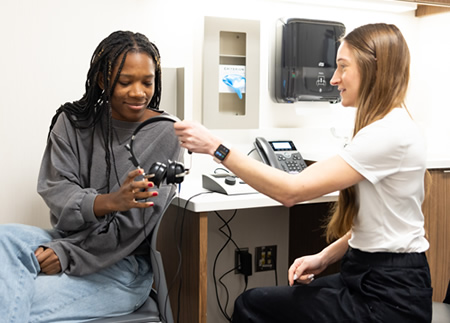Two CSD Graduate Programs Get High Marks from US News and World Report
It’s breaking silos between clinical services and research, and between the clinic and the community. But also, that we’re leveraging being a part of the School of Communication and leading innovative programming and partnerships”
Bharath Chandrasekaran
Department Chair and Ralph and Jean Sundin Professor of Communication Sciences and Disorders
Two powerhouse flagship programs in the School of Communication got a welcome boost in rankings in US News and World Report’s latest assessment of graduate education.
Announced on April 8, the Doctor of Audiology (AuD) program is now at the number 2 spot, up from number 3, among U.S. college and university audiology programs while the Master of Science in Speech, Language, and Learning (MSSLL) holds the number 3 spot amid its peer programs, up from number 4. Both programs are housed in the Roxelyn and Richard Pepper Department of Communication Sciences and Disorders (CSD).
“We have really been pushing at breaking silos,” says Bharath Chandrasekaran, department chair and the Ralph and Jean Sundin Endowed Professor. “And not just greater collaboration within the department; it’s breaking silos between clinical services and research, and between the clinic and the community. But also, that we’re leveraging being a part of the School of Communication and leading innovative programming and partnerships.”
For instance, CSD is partnering with the Department of Theatre in three separate initiatives: introducing kids and teens who stutter to improv; offering vocal screenings for music theatre students; and engaging graduate students in the research behind new theatre programming for infants and very young children. Additionally, budding local and global collaborations will facilitate important cross-cultural and -disciplinary projects and discoveries.
 Chandrasekaran says that these and other efforts, in tandem with the demonstrated excellence of the department’s research and clinical science wings, has greatly benefited the graduate programs. Administrative support has gone a long way as well.
Chandrasekaran says that these and other efforts, in tandem with the demonstrated excellence of the department’s research and clinical science wings, has greatly benefited the graduate programs. Administrative support has gone a long way as well.
“These programs have been in the top five for a while, but I do believe there’s renewed excitement with new hires, expanded programming in the clinic, and more offerings that are community centered,” he says. “And of course the support from Dean. E. Patrick Johnson in envisioning what the department can be.”
The highly specialized and selective AuD program welcomes about 18 students each year for 12 quarters of academics, supervised clinical practicums, and capstone research work. Led by program director Kristine Riley, students can explore hearing loss and management, speech perception, psychoacoustics, cochlear physiology, auditory neuroscience, and beyond. MSSLL combines concept-based and immersive curricula with clinical training, team-based learning, and ample support and assessment to prepare clinicians for leadership in this rapidly changing and explosively growing field. Program director Stacy Kaplan oversees about 125 students across both years of the two-year program.
The Northwestern University Center for Audiology, Speech, Language, and Learning (NUCASLL), as well as partnerships with Northwestern Medicine, have been pivotal to the success and reputation of the department and the graduate programs. NUCASLL, which moved to state-of-the-art facilities in 2015, combined the independent audiology and speech-language pathology clinics under one interdisciplinary roof while simultaneously expanding services for patients across the lifespan.
But as important, the facility operates as an invaluable teaching tool for students enrolled in the AuD and MSSLL programs.
“We are incredibly fortunate to develop our students in a thriving facility with clinical supervisors who have deep expertise in a wide variety of service areas,” Kaplan says. “Our students gain experience with a wide variety of clientele, ranging from toddlerhood to senescence, as well as a variety of service models, including individual, intensive, and group treatment and telehealth. These clinical experiences, in tandem with an evidence-based curriculum and exceptional faculty, prepare our speech-language pathologists-to-be for a smooth transition into the field.”
In-house clinics at universities are somewhat rare, Chandrasekaran says, and the scale of NUCASLL certainly is.
“We have one of the best university clinics out there, which accommodates between 5,000 and 7,000 sessions a year,” he says. “And we have faculty representing both basic science and clinical practice and research.”
The student component is an added asset.
“Students in the AuD program begin their clinical development at NUCASLL in just the second week of their studies,” Riley says. “One of the aspects of our program I'm most proud of is that our clinical and academic faculty work in tandem to ensure that students integrate theoretical knowledge with clinical skills enabling them to provide the best hearing healthcare possible to their patients.”
Vanderbilt University occupies the top spot in both categories, but Chandrasekaran notes that the gap is closing. And while good rankings are a boon to recruitment, they don’t define the programs.
“We are striving for excellence,” he says. “Not just No. 1 in the ranking; we are striving to be the leader—the incubator—for innovation and the next generation of discoveries.”
US News and World Report publishes AuD and MSSLL rankings annually, a change from the preexisting once-in-three-years model. The publication uses statistical and peer assessment data in addition to student outcomes, faculty research, and institutional reputation to guide its rankings. Northwestern Feinberg School of Medicine programs in clinical psychology, physician assistant, and physical therapy also made their respective lists.
